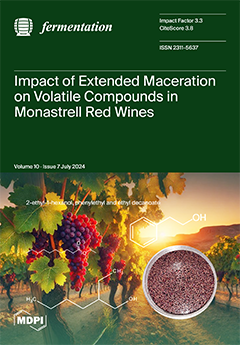Sour beers play an important role in the brewing market, and their production has been growing exponentially. In light of this, six microorganisms directly related to this class of beer were studied, and the fermentation behavior of six strains used in the past for traditional commercial
Berliner Weisse beer production was monitored. The microorganisms used were
Lactobacillus brevis,
Lactobacillus parabrevis,
Brettanomyces bruxellensis, and
Brettanomyces anomalus and two strains of
Saccharomyces cerevisiae. The six microorganisms were selected in a previous work, and a comparison between single and mixed fermentations was carried out via daily measurements of the fermentation parameters like pH, extract, and cell count during 22 days. The ability to isolate a specific microorganism from a mixed culture was investigated using three commonly used nutrient media and aerobic/anaerobic growth conditions. Both
Lactobacillus and
Brettanomyces could be isolated; however, the conditions imposed were not sufficient in order to isolate
Saccharomyces. Fermentations carried out with LAB and
Brettanomyces showed a decrease in
Lactobacillus growth if compared to pure fermentations, but no influence on the growth of
Brettanomyces could be perceived. In general, fermentations carried out in the presence of
Saccharomyces were dominated by this yeast. Its quick growth seems to be responsible for the high end pH values observed as well as the decrease in cell growth for both LAB and
Brettanomyces. A decrease in the cell viability of
Saccharomyces was followed by an increased growth of the other microorganisms involved, possibly meaning that the molecules released through apoptosis are used by both LAB and
Brettanomyces as a valuable nutrient source. The volatile compound concentrations of the first group were higher in fermentations with
Saccharomyces, whereas esters’ concentration was higher in fermentations carried out only with
Brettanomyces and
Lactobacillus. Furthermore, understanding how these microorganisms interact during the fermentation process can help brewers better control production and ensure the consistency in the quality of the final product. The end pH values and acidity reached levels acceptable for
Berliner Weisse beer. This innovative approach certainly contributes to the evolution and refinement of the art of brewing.
Full article





